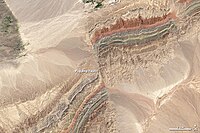
Photo from wikipedia
Plate subduction is the largest natural factory that processes elements, which controls recycling and mineralization of a variety of elements. There are three major ore deposit belts in the world:… Click to show full abstract
Plate subduction is the largest natural factory that processes elements, which controls recycling and mineralization of a variety of elements. There are three major ore deposit belts in the world: the circum-Pacific, the central Asian, and the Tethys belts. All the three belts are closely associated with plate subductions, the mechanism remains obscure. We approached this problem from systematic studies on the behaviours of elements during geologic processes. This contribution summaries the recent progress of our research group. Our results suggest that porphyry Cu deposits form through partial melting of subducted young oceanic crust under oxygen fugacities higher than ΔFMQ ∼+1.5, which is promoted after the elevation of atmospheric oxygen at ca. 550 Ma. Tin deposits are associated with reducing magmatic rocks formed as a consequence of slab rollback. The Neo-Tethys tectonic regime hosts more than 60% of the world’s total Sn reserves. This is due to the reducing environment formed during the subduction of organic rich sediments. For the same reason, porphyry Cu deposits formed in the late stages during the closure of the Neo-Tethys Ocean. Tungsten deposits are also controlled by slab rollback, but is not so sensitive to oxygen fugacity. Subduction related W/Sn deposits are mostly accompanied by abundant accessory fluorites due to the breakdown of phengite and apatite. Decomposition of phengite is also significant for hard rock lithium deposits, whereas orogenic belt resulted from plate subduction promote the formation of Li brine deposits. Cretaceous red bed basins near the Nanling region are favorable for Li brines. Both Mo and Re are enriched in the oxidation-reduction cycle during surface processes, and may get further enriched once Mo-, Re-enriched sediments are subducted and involved in magmatism. During plate subduction, Mo and Re fractionate from each other. Molybdenum is mainly hosted in porphyry Mo deposits and to a less extent, porphyry Cu-Mo deposits, whereas Re is predominantly hosted in porphyry Cu-Mo deposits and sedimentary sulfide deposits.
Journal Title: Journal of Oceanology and Limnology
Year Published: 2019
Link to full text (if available)
Share on Social Media: Sign Up to like & get
recommendations!